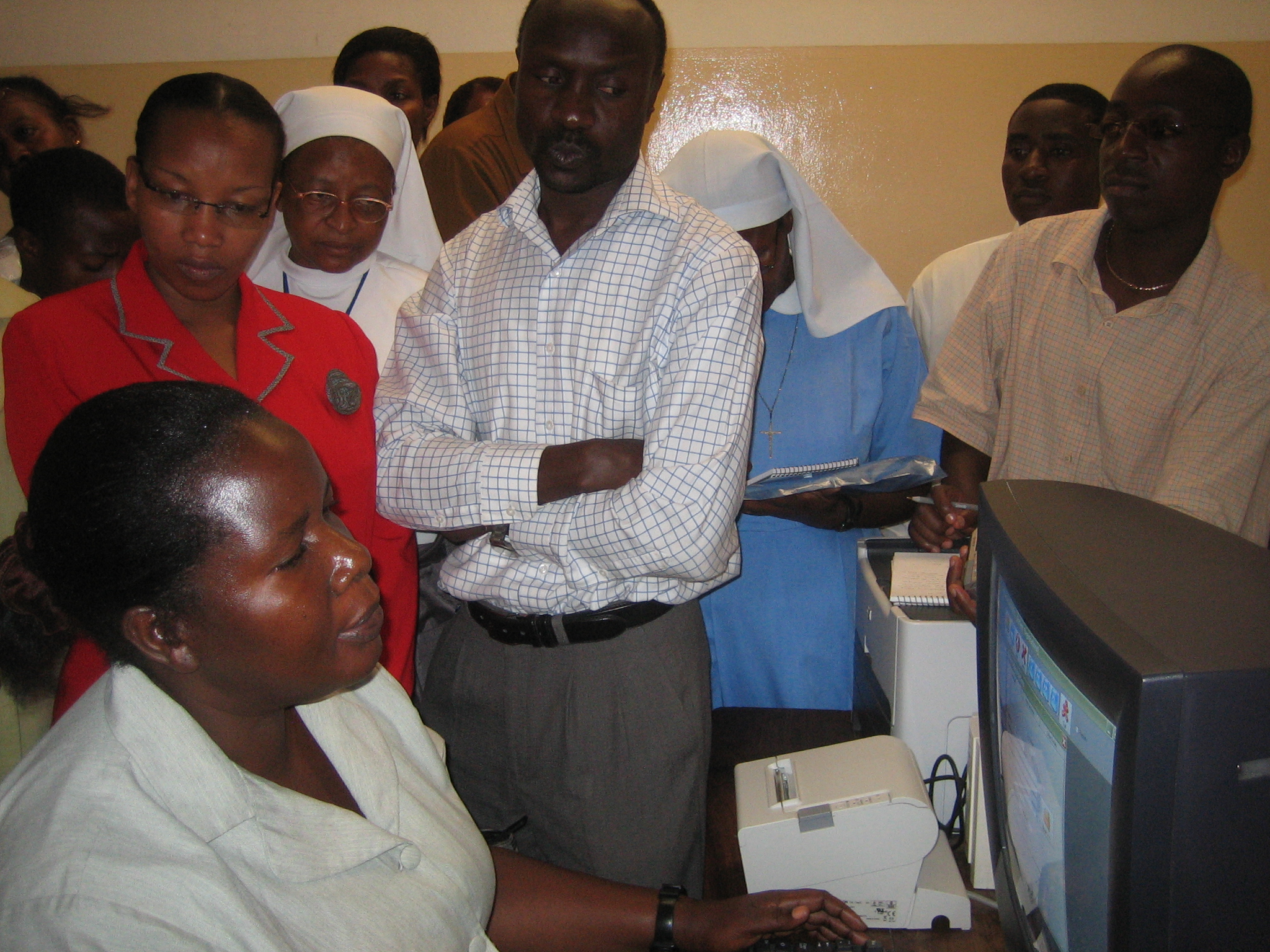Featured article of the week: June 30–July 6, 2014:
A hospital information system (HIS) (sometimes referred to as a healthcare information system or clinical information system) is a comprehensive, integrated information system designed to manage the medical, administrative, financial, and legal aspects of a hospital and its service processing. As information management demands become more rigorous, "hospitals are becoming more reliant on the ability of [a] hospital information system (HIS) to assist in the diagnosis, management and education for better and improved services and practices."
A modern HIS may be composed of one or more software components, including specialty-specific extensions as well as a large variety of sub-systems in medical specialties, including laboratory information systems, (LISs), radiology information systems (RISs) or picture archiving and communication systems (PACSs). The HIS handles patient care management, procedure management, human resource management, and cost and accounting among many other activities. (Full article...)
Featured article of the week: June 23–29, 2014:
Imaging informatics (also known as radiology informatics or medical imaging informatics) involves the intersection between health informatics and bioinformatics that aims to improve the efficiency, accuracy, usability, and reliability of medical imaging services within the context of the healthcare environment. "Notably, medical imaging informatics addresses not only the images themselves, but encompasses the associated data to understand the context of the imaging study; to document observations; and to correlate and reach new conclusions about a disease and the course of a medical problem."
More specifically it is devoted to the study of how information about and contained within medical images is acquired, stored, exchanged, analyzed, and enhanced throughout the medical enterprise. Medical images must be in a standard, symbolic, and reproducible format for proper acquisition and storage. Computer-related transmission protocols like TCP/IP, HTTP, and DICOM as well as organized, sensical transaction diagrams are required for proper data exchange. And because of all those protocols and standards, software can be created and utilized to analyze, enhance, and even mine medical images for useful real-world healthcare data. (Full article...)
|
Featured article of the week: June 16–22, 2014:
A reference laboratory can be defined in many different ways; however, there are two broad senses to the term.
1. a laboratory that performs reference or calibration measurement procedures or assigns reference values to test objects, later potentially providing those associated reference values for references or sources of traceability of test results; alternate names include: reference measurement, reference testing, and calibration laboratory
2. a laboratory — typically privately-owned — that performs quality and cost-effective high-volume and esoteric testing of biological samples for physicians, hospitals, and other laboratories; alternate names include: referral or diagnostic laboratory
The idea of a laboratory dedicated to performing reference measurements for the benefit of the general public apparently had been conceived and implemented in Germany before the beginning of the twentieth century. However, the idea of a reference laboratory as an independent referral or diagnostic facility that handles many samples and a wide variety of tests is likely a more recent phenomena. (Full article...)
|
Featured article of the week: June 9–15, 2014:
Geoinformatics is a multidisciplinary field of science that uses technologies supporting the processes of acquiring, analyzing, and visualizing geospatial data. Historically, the definition of the term "geoinformatics" has varied over the years. Some geological researchers like G. Randy Keller explain geoinformatics as the use of "data, software tools, and computational infrastructure ... to facilitate studies of the structure, dynamics, and evolution of the solid Earth through time, as well as the processes that act upon it and within it from the near surface to the core." Other definitions of geoinformatics dutifully extend its scope to the surface of the planet, causing more confusion as terms like "geomatics," "geographical information system," and "computational geography" are brought to the discussion from different regions around the world and are often used synonymously.
Geoinformatics can help tackle problems and tasks such as modeling seismic data, producing astrogeological 3D maps, and planning and managing land use. (Full article...)
|
Featured article of the week: June 2–8, 2014:
The Practical Guide to the U.S. Physician Office Laboratory is a white paper created by the Laboratory Informatics Institute on the topic of the physician office laboratory (POL) in the United States. The white paper was published on May 14, 2014 and discusses several aspects of the POL, including what it is, how it operates, and how it's regulated. Rather than making specific recommendations, the paper focuses on providing a broad, generalized overview of topics related to the POL.
In many countries like the United States, the POL is considered a clinical laboratory and is thus regulated by federal, state, and/or local laws affecting such laboratories. The paper discusses the regulations primarily affecting those laboratories as well as how how those regulations play into analyzing economic considerations like start-up cost and return on investment. Finally, it also includes an addendum containing an extensive list of conferences, consultants, organizations, and published materials that could potentially help those operating and working in a POL. (Full article...)
|
Featured article of the week: May 26–June 1, 2014:
Informatics is the science of information, the practice of information processing, and the engineering of information systems. Informatics studies the structure, algorithms, behavior, and interactions of natural and artificial systems that store, process, access, and communicate information. It also develops its own conceptual and theoretical foundations and utilizes foundations developed in other fields. Since the advent of computers, individuals and organizations increasingly process information digitally. This has led to the study of informatics that has computational, cognitive, and social aspects, including study of the social impact of information technologies.
While the field of informatics encompasses the study of systems that represent, process, and communicate information, the theory of computation in the specific discipline of theoretical computer science which evolved from Alan Turing studies the notion of a complex system regardless of whether information actually exists. Since both fields process information, there is some disagreement among scientists as to field hierarchy. (Full article...)
|
Featured article of the week: May 19–25, 2014:
An assisted living facility (ALF) (sometimes referred to as an assisted living residence or adult living facility) is a housing facility for people with disabilities. The ALF acts as an intermediary step between independent living and a skilled nursing facility, offering health and care assistance while also promoting people's desire for independent activity. These facilities provide supervision or assistance with activities of daily living (ADLs); coordination of services by outside health care providers; and monitoring of resident activities to help to ensure their health, safety, and well-being.
In the United States, the Centers for Medicare and Medicaid Services (CMS) requires states to report on oversight methodologies and asks states to survey whether residents are getting appropriate care; however, the assisted living facility has largely been unregulated at the federal level, leaving the states to regulate and license them. More than two-thirds of the states use the licensure term "assisted living." Other licensure terms used for this philosophy of care include residential care home, assisted care living facilities, and personal care homes. (Full article...)
|
Featured article of the week: May 12–18, 2014:
An electronic health record (EHR) is an evolving concept, "defined as a longitudinal collection of electronic health information about individual patients and populations." It is a record in digital format that is theoretically capable of being shared across different health care settings. In some cases this sharing can occur by way of network-connected enterprise-wide information systems and other information networks or exchanges. EHRs may include a range of data, including demographics, medical history, medication and allergies, immunization status, laboratory test results, radiology images, vital signs, personal stats like age and weight, and billing information.
The differences between an EHR and an electronic medical record (EMR) differ from entity to entity and from country to country. For example, the U.S. Department of Health and Human Services (HHS) notes that despite the interchanging of the terms "EMR" and "EHR," it considers them two separate entities: the EMR came first, used primarily by medical clinicians for diagnosis and treatment, while the EHR came into existence as a more holistic, inclusive collection of a patient's health data. (Full article...)
|
Featured article of the week: May 5–11, 2014:
A public health laboratory is a laboratory that serves regional, national, or in some cases global communities by providing clinical diagnostic testing, environmental testing, disease diagnosis and evaluation, emergency response support, applied research, regulation and standards recommendations, laboratory training, and other essential services to the communities they serve.
A public health laboratory is unlike the average commercial laboratory as it functions as a core part of a broad public health system. The public health laboratory must typically meet more stringent requirements, including adhering to the Clinical Laboratory Improvement Amendments (CLIA) (for labs in the United States) as well as regulations laid out by the departments, agencies, and other regulatory bodies of local, state, and/or national governments. Finally, the private medical laboratory focuses on tests that diagnose the diseases of individuals, while the functions of the public health laboratory serve entire populations.
On a global level, the public health laboratory is influenced and supported by the the World Health Organization (WHO) and the Association of Public Health Laboratories (APHL). In the U.S. they are influenced, overseen, and/or regulated by several federal agencies. (Full article...)
|
|

















